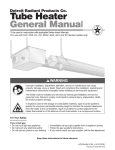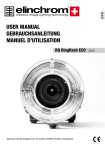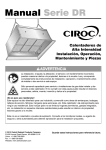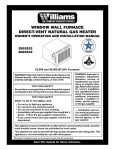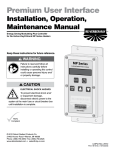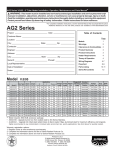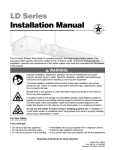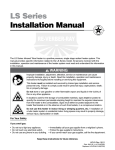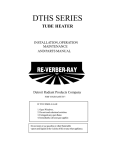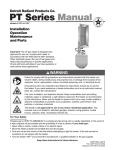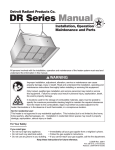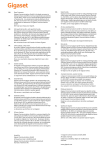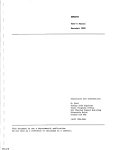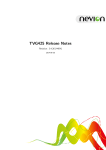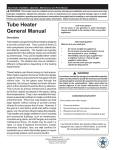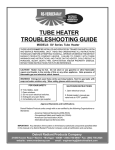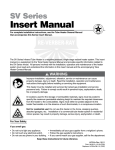Download Detroit Radiant Products heater Troubleshooting guide
Transcript
Detroit Radiant Products Co. Tube Heater General Manual To be used in conjunction with Series 3 insert manuals. ! WARNING Improper installation, adjustment, alteration, service or maintenance can cause property damage, injury or death. Read and understand the installation, operating and maintenance instructions thoroughly before installing or servicing this equipment. This heater must be installed and serviced by trained gas installation and service personnel only. Failure to comply could result in personal injury, asphyxiation, death, fire and/or property damage. In locations used for the storage of combustible materials, signs must be posted to specify the maximum permissible stacking height to maintain the required clearances from the heater to the combustibles. Signs must either be posted adjacent to the heater thermostats or in the absence of such thermostats, in a conspicuous location. For Your Safety If you smell gas: • Do not try to light any appliance. • Immediately call your gas supplier from a neighbor’s phone. • Do not touch any electrical switch. • Follow the gas supplier’s instructions. • Do not use any phone in your building. • If you cannot reach your gas supplier, call the fire department. Keep these instructions for future reference. Form: LIOGT3-10211 Print:5M-4/13-r1_6/13 (CDS) Replaces:LIOGT3-5M-8/12 (CDS) Contents 1.0Introduction . . . . . . . . . . . . . . . . . . . . . . . . . . . . . . . . . . . . . . . . . . . . . . . . . . . . . . . . . . . . . . 3 Overview . . . . . . . . . . . . . . . . . . . . . . . . . . . . . . . . . . . . . . . . . . . . . . . . . . . . . . . . . . . . . 3 Heater Components . . . . . . . . . . . . . . . . . . . . . . . . . . . . . . . . . . . . . . . . . . . . . . . . . . . 3 2.0 Safety . . . . . . . . . . . . . . . . . . . . . . . . . . . . . . . . . . . . . . . . . . . . . . . . . . . . . . . . . . . . . . . . . . . 4 Warning Symbols . . . . . . . . . . . . . . . . . . . . . . . . . . . . . . . . . . . . . . . . . . . . . . . . . . . . . 4 Applications . . . . . . . . . . . . . . . . . . . . . . . . . . . . . . . . . . . . . . . . . . . . . . . . . . . . . . . . . . 4 Clearance to Combustibles . . . . . . . . . . . . . . . . . . . . . . . . . . . . . . . . . . . . . . . . . . . . . . 5 Safety Signs and Labels . . . . . . . . . . . . . . . . . . . . . . . . . . . . . . . . . . . . . . . . . . . . . . . . . 5 Venting . . . . . . . . . . . . . . . . . . . . . . . . . . . . . . . . . . . . . . . . . . . . . . . . . . . . . . . . . . . . . . 6 Gas Supply . . . . . . . . . . . . . . . . . . . . . . . . . . . . . . . . . . . . . . . . . . . . . . . . . . . . . . . . . . 6 Heater Expansion . . . . . . . . . . . . . . . . . . . . . . . . . . . . . . . . . . . . . . . . . . . . . . . . . . . . . 6 Standards, Certifications and Government Regulations . . . . . . . . . . . . . . . . . . . . . . . . 7 3.0 Installation . . . . . . . . . . . . . . . . . . . . . . . . . . . . . . . . . . . . . . . . . . . . . . . . . . . . . . . . . . . . . . . 9 Design Considerations and Prechecks . . . . . . . . . . . . . . . . . . . . . . . . . . . . . . . . . . . . . 9 Hanger Placement and Suspension . . . . . . . . . . . . . . . . . . . . . . . . . . . . . . . . . . . . . . . 12 Radiant Tube Assembly . . . . . . . . . . . . . . . . . . . . . . . . . . . . . . . . . . . . . . . . . . . . . . . . . 16 Optional Elbow or U-Bend Accessory Configuration . . . . . . . . . . . . . . . . . . . . . . . . . . 17 Burner Control Box Suspension . . . . . . . . . . . . . . . . . . . . . . . . . . . . . . . . . . . . . . . . . . 19 Reflector Assembly . . . . . . . . . . . . . . . . . . . . . . . . . . . . . . . . . . . . . . . . . . . . . . . . . . . . 20 Baffle Assembly and Placement . . . . . . . . . . . . . . . . . . . . . . . . . . . . . . . . . . . . . . . . . . 22 Final Heater Assembly . . . . . . . . . . . . . . . . . . . . . . . . . . . . . . . . . . . . . . . . . . . . . . . . . 23 Venting . . . . . . . . . . . . . . . . . . . . . . . . . . . . . . . . . . . . . . . . . . . . . . . . . . . . . . . . . . . . . 24 Sidewall (Horizontal) Venting . . . . . . . . . . . . . . . . . . . . . . . . . . . . . . . . . . . . . . . . . . . . . 25 Roof (Vertical) Venting . . . . . . . . . . . . . . . . . . . . . . . . . . . . . . . . . . . . . . . . . . . . . . . . . . 26 Optional Unvented Operation . . . . . . . . . . . . . . . . . . . . . . . . . . . . . . . . . . . . . . . . . . . . . 28 Combustion Air Requirements . . . . . . . . . . . . . . . . . . . . . . . . . . . . . . . . . . . . . . . . . . . 28 Gas Supply . . . . . . . . . . . . . . . . . . . . . . . . . . . . . . . . . . . . . . . . . . . . . . . . . . . . . . . . . . 30 4.0 Operation . . . . . . . . . . . . . . . . . . . . . . . . . . . . . . . . . . . . . . . . . . . . . . . . . . . . . . . . . . . . . . . . . 33 5.0 Maintenance . . . . . . . . . . . . . . . . . . . . . . . . . . . . . . . . . . . . . . . . . . . . . . . . . . . . . . . . . . . . . . 34 Troubleshooting Guide . . . . . . . . . . . . . . . . . . . . . . . . . . . . . . . . . . . . . . . . . . . . . . . . . 35 6.0 Limited Warranty . . . . . . . . . . . . . . . . . . . . . . . . . . . . . . . . . . . . . . . . . . . . . . . . . . . . . . . . . . 36 2 1.0 Introduction • Overview • Heater Components 1.0 Introduction Overview The intent of this manual is to provide information regarding general safety, installation, operation and maintenance of the tube heater. For complete assembly and installation instructions, use this Tube Heater General Manual in conjunction with the Series Insert Manual that accompanies this piece. You must read, and understand, the instructions and safety warnings in both manuals before installing the tube heater. Heater Components* Prior to installation, verify that the heater’s gas type and voltage (as listed on the rating plate) match that of your application. Also verify that you have received all heater contents included with your tube heater. Refer to the Series Insert for a list of the kit contents for your Series heater. Materials not included in the heater kit contents (e.g., screws, vent material, terminals, etc.) are the responsibility of the installer. Notify your product representative or Detroit Radiant Products of any discrepancy or missing kit contents prior to installing unit. Tube Hanger Figure 1.1 • Heater Components* Chains are not provided in kit. Optional accessory. P/N: THCS Reflector 10 ft. Primary/ Secondary Combustion Chamber(s) Radiant Tube(s) Reflector Center Support Tube Hanger Reflector End Cap with Clips* Burner Control Box Igniter/ Sensor Box Baffles Tube Clamp 16 in. Burner Tube SS Flex Connector* * Not all items illustrated may be provided with your heater. Refer to kit contents of the Series Insert Manual. 3 2.0 Safety • Warning Symbols • Applications 2.0 Safety ! WARNING Improper installation, adjustment, alteration, service or maintenance can cause property damage, serious injury or death. Read and understand, the installation, operating and maintenance instructions thoroughly before installing or servicing this equipment. Only trained, qualified gas installation and service personnel may install or service this equipment. Warning Symbols Safety is the most important consideration during installation, operation and maintenance of the tube heater. You will see the following symbols and signal words when there is a hazard related to safety or property damage. ! ! WARNING Warning indicates a potentially hazardous situation which, if not avoided, could result in death or injury. CAUTION Caution indicates a potentially hazardous situation which, if not avoided, could result in minor or moderate injury. NOTICE Notice indicates a potentially hazardous situation which, if not avoided, could result in property damage. Applications This is not an explosion proof heater. No tube heater may be used in a Class 1 or Class 2 Explosive Environment. Consult your local fire Marshall, insurance carrier and other authorities for approval if the proposed installation is in question. Commercial / Industrial Unless otherwise indicated, tube heaters are designed and certified for use in industrial and commercial buildings, such as warehouses, manufacturing plants, aircraft hangars and vehicle maintenance shops. For maximum safety the building must be evaluated for potential problems before installing the heating system. A critical safety factor to consider before installation is the clearance to combustibles. ! WARNING Not For Residential Use. Installation of a commercial tube heater system in residential indoor spaces may result in property damage, serious injury or death. 4 2.0 Safety • Clearance to Combustibles • Safety Signs and Labels Clearance to Combustibles ! WARNING Placement of explosive objects, flammable objects, liquids and vapors close to the heater may result in explosion, fire, property damage, serious injury or death. Do not store or use explosive objects, liquids and vapor in the vicinity the heater. Hazards: For maximum safety the building must be evaluated for hazards before installing the heating system. Examples include, but are not limited to: • • • • • • • Gas and electrical lines Combustible and explosive materials Chemical storage areas Areas of high chemical fume concentrations Provisions for accessibility to the heater Adequate clearances around air openings Combustion and ventilating air supply • • • • • • • Vehicle parking areas Vehicles with lifts or cranes Storage areas with stacked materials Lights Sprinkler heads Overhead doors and tracks Dirty, contaminated environment A critical safety factor to consider before installation is the clearances to combustibles. Clearance to combustibles is defined as the minimum distance you must have between the tube surface, or reflector, and the combustible item. Considerations must also be made for moving objects around the tube heater. The following is a partial list of items to maintain clearances from: Combustible items: Moving Objects: • • • • • • • • Wood Paper Fabric Chemicals • • • • Paint Parked vehicles Gasoline Storage racks Overhead doors Vehicle lifts Cranes Hoists When installing the tube heating system, the minimum clearances to combustibles for your Series tube heater and system configuration must be maintained. These distances are shown in your Series Insert Manual and on the burner control box. If you are unsure of the potential hazards, consult your local fire Marshall, fire insurance carrier or other qualified authorities on the installation of gas fired tube heaters for approval of the proposed installation. Safety Signs and Labels It is important to provide warnings to alert individuals to potential hazards and safety actions. ANSI Z83.20b and CSA 2.34 require you to post a sign “specifying the maximum permissible stacking height to maintain the required clearances from the heater to the combustibles” near the heaters thermostat or in absence of such thermostats in a conspicuous location. Contact Detroit Radiant Products Co. or an authorized dealer for Clearance Safety Limit Signs or for Clearance Safety Limit Tags (one tag is provided with each heater). Safety warning labels must be maintained on the tube heater. Illustrations of the safety labels, and their locations, are pictured in the Series Insert Manual. In locations used for the storage of combustible materials, signs must be posted to specify the maximum permissible stacking height to maintain the required clearances from the heater to combustibles. Signs must either be posted adjacent to the heater thermostats or in the absence of such thermostats in a conspicuous location. 5 2.0 Safety • Venting • Gas Supply • Heater Expansion Venting ! WARNING Insufficient ventilation may result in health problems, carbon monoxide poisoning and death. Vent enclosed spaces and buildings according to national, state, provincial and local codes. This tube heater must be vented in accordance with national, state, provincial and local codes and the guidelines in the Detroit Radiant Tube Heater General (refer to pages 24 - 28) and applicable Series Insert Manual. In the United States refer to the latest edition of the ANSI Z223.1 (NFPA 54) Standard and in Canada refer to the latest edition of the CAN/CGA B149.1 Standard. Gas Supply ! WARNING Improperly connected gas lines may result in serious injury and death, explosion, poisonous fumes, toxic gases or asphyxiation. Connect gas lines in accordance to national, state, provincial and local codes. The gas supply to the tube heater must be connected and tested in accordance with national, state, provincial and local codes along with the guidelines in the Tube Heater General Manual (refer to pages 31-32) and Series Insert Manual. In the United States refer to the latest edition of the ANSI Z223.1 (NFPA 54) Standard and in Canada refer to the latest edition of the CAN/CGA B149.1 Standard. Heater Expansion ! WARNING Allowances must be made for the system to expand. Improper installation, adjustment, alteration, service or maintenance can cause property damage, injury or death. A flexible gas connection of approved type is required. Connectors must be installed in one plane and without sharp bends, kinks or twists. The tube heater expands and contracts during operation. Follow the installation instructions to ensure allowances are made for this movement. To ensure your safety, and comply with the terms of the warranty, all units must be installed in accordance with these instructions. 6 2.0 Safety • Standards, Certifications and Government Regulations Standards, Certifications and Government Regulations Installation of this tube heater must comply with all applicable local, state and national specifications, regulations and building codes. Contact the local building inspector and/or fire marshall for guidance. In the absence of local codes, the installation must conform to the latest edition of: United States: National Fuel Gas Code, ANSI Z223.1 (NFPA 54). Canada: CAN/CGA B149.1 and .2, Canadian Electrical Code C22.1 Chart 2.1 • Standards and Code Installation Guidelines • Building Type Building Type Public Garages Codes and Guidelines Installation of this tube heater in public garages must conform to the following codes: United States: Standard for Parking Structures NFPA 88A (latest edition) or the Code for Motor Fuel Dispensing Facilities and Repair Garages NFPA 30A (latest edition). Canada: Refer to CAN/CGA B149.1: Installation Codes for Gas Burning Appliances and applicable Standards for Public Garages. Guidelines: • Heaters must not be installed less than 8 ft. (2.4 m) above the floor. Minimum clearances to combustibles must be maintained from vehicles parked below the heater. • When installed over hoists, minimum clearances to combustibles must be maintained from the upper most point of objects on the hoist. Aircraft Hangars Installation of this tube heater in aircraft hangars must be in accordance with the following codes: United States: Refer to Standard for Aircraft Hangars, ANSI/NFPA 409 (latest edition). In Canada:Refer to Standard CAN/CGA B149.1 and applicable Standards for Aircraft Hangars. Guidelines: • In aircraft storage and servicing areas, heaters shall be installed at least 10 ft. (3 m) from above the upper surface of wings or of the engine enclosures of the highest aircraft that may be housed in the hangar. The measurement shall be made from the wing or engine enclosure, whichever is higher from the floor, to the bottom of the heater. • In areas adjoining the aircraft storage area (e.g., shops, offices) the bottom of heaters shall be installed no less than 8 ft. (2.4 m) above the floor. • Suspended or elevated heaters shall be located in spaces where they shall not be subject to damage by aircraft, cranes, movable scaffolding or other objects. Provisions shall be made to assure accessibility to suspended tube heaters for recurrent maintenance purposes. 7 2.0 Safety • Standards, Certifications and Government Regulations Chart 2.2 • Standards and Code Installation Guidelines • Building Location Building Location High Altitude Guidelines Guidelines: Installation of this tube heater is approved, without modifications, for elevations up to 6,000 feet (1,829 m) MSL (sea level) in the United States. Contact the factory for installations above these elevations. The type of gas appearing on the nameplate must be the type of gas used. Installation must comply with national and local codes and requirements of the local gas company. NonStandard BTU Gas Guidelines: Unless otherwise noted on the rating plate, this infrared heater is designed and orificed to operate on standard BTU gas. Contact the factory if utilizing non-standard BTU gas. Chart 2.3 • Standards and Code Installation Guidelines • Building Aspect Building Aspect Electrical Codes and Guidelines The tube heater must be electrically grounded in accordance with the following codes: United States: Refer to National Electrical Code®, ANSI/NFPA 70 (latest edition). Wiring must conform to the latest edition of National Electrical Code®, local ordinances, and any special diagrams furnished. Canada: Refer to Canadian Electrical Code CSA C22.1 Part 1 (latest edition). Venting Venting must be installed in accordance with the requirements within this manual and the following codes: United States: Refer to NFPA 54/ANSI Z223.1 (latest edition), National Fuel Gas Code. Canada: Refer to CAN/CGA B149.1 Installation Codes for Gas Burning Appliances. Applicable authorities governing the manufacturing or installation of this infrared heater include (but are not limited to) the following organizations: • NFPA - National Fire Protection Association. • IAS - International Approval Services. • ANSI Z83.20b - American National Standards Institute. • AGA - American Gas Association. • NFPA 54/ANSI Z223.1 - National Fuel Gas Code. • CE - Certification of Europe. • CSA - Canadian Standards Association. • IRSC- Infrared Heater Safety Council. • OSHA - Occupational Safety & Health Administration. NOTE: Refer to the Series Insert Manual for model specific certifications and approvals. 8 3.0 Installation • Design Considerations and Prechecks 3.0 Installation ! WARNING Improper installation, adjustment, alteration, service or maintenance can cause property damage, serious injury or death. Read and understand, the installation, operating and maintenance instructions thoroughly before installing or servicing this equipment. Only trained, qualified gas installation and service personnel may install or service this equipment. Design Considerations and Prechecks Placement of infrared heaters is influenced by many factors. Aside from safety factors, considerations such as the number of heater or vent elbows that are allowed, maximum vent lengths, ducting of combustion air and combining exhaust vents are a few examples. To ensure a properly designed heating system, a layout should be developed for the correct placement of the burner control box, tubes, vents and combustion air intake ducts. Inspect and evaluate the mounting conditions, vent locations, gas supply and wiring. When designing an infrared radiant heating system, consider the following: • Has the building’s heat loss been evaluated? • Does the design meet the needs of the space? • Have recommended mounting heights been observed? • Have all clearance to combustibles situations been observed? • Is the supply (burner) end of the heater located where more heat is required? • Is it best to offset the heaters and/or rotate the reflectors towards the heat zone? • Are extra guards, side shields, ‘U’ or ‘L’ reflector covers required? • Does the heater require outside fresh air for combustion? • Is the environment harsh or contaminated (requiring outside air for combustion)? • Are wind barriers required? The effective infrared surface temperature of a person or object may be diminished with wind/drafts above 5 mph. • Are chemicals or vapors a concern (requiring outside air for combustion or additional ventilation)? IMPORTANT: Fire sprinkler heads must be located at an appropriate distance from the heater to avoid an inadvertent discharge. This distance may exceed the published clearance to combustibles. Certain applications may require the use of high temperature sprinkler heads or the relocation of the heaters. ! CAUTION Fire sprinkler systems containing propylene glycol, antifreeze or other potentially flammable substances shall not to be used in conjunction with this heater without careful consideration for and avoidance of inadvertent discharge hazards. For further information consult NFPA 13. Always observe applicable state and local codes. 9 3.0 Installation • Design Considerations When heated, materials high in hydrocarbons (solvents, paint thinner, mineral spirits, formaldehydes, etc.) can evaporate. This may result in odors or fumes being emitted into the environment. To correct this problem, clean the area and/or introduce additional ventilation. The heaters themselves, when installed and serviced in accordance with the installation manual, do not emit foul odors into the environment. Design Scenario: A tube heater system is being installed in a 90’ (L) x 50’ (W) x 14’ (H) space. Two overhead doors are located at one end and an equipment storage area on one side. The calculated heat load is 400,000 BTU/h. Figure 3.1 • Poor Design 90’ Gas Supply 80’ - 200,000 BTU (2 total) Doors and tracks Equipment storage Too Hot Too Cold Doors and tracks 50’ Poor Design • Two burners (200,000 BTU each) are placed at one end, opposite the area of highest demand (e.g., overhead doors). • Recommended mounting heights are not observed (see Chart 3.1). • Produces an uneven heat distribution. Figure 3.2 • Good Design 90’ Gas Supply 40’ - 100,000 BTU (4 total) Doors and tracks Equipment storage Better Heat Distribution Doors and tracks 50’ Good Design Sidewall Vent (2 total) • Four burners (100,000 BTU each) are placed in each corner. Burner (hotter) ends direct heat to areas of highest heat demand. • Recommended mounting heights have been observed. • Distributes heat more evenly. 10 3.0 Installation • Recommended Mounting Heights and Coverages Chart 3.1 • Recommended Mounting Heights and Coverages Recommended Mounting Height (ft.) Coverage Area Straight Config. (LxW) Coverage Area U-Tube Config. (LxW) Distance Between Heaters (ft.) Dimension A Distance Between Heater Rows (ft.) Dimension B Maximum Distance Between Heaters and Wall (ft.) Dimension C 50-65 MBH 10’ - 16’ 20’ x 12’ 12’ x 12’ 10’ - 20’ 20’ - 40’ 16’ 75-100 MBH 12’ - 20’ 22’ x 15’ N/A 20’ - 30’ 30’ - 50’ 18’ 50-65 MBH 10’ - 16’ 30’ x 14’ 17’ x 13’ 10’ - 20’ 20’ - 40’ 17’ 75-125 MBH 12’ - 20’ 33’ x 18’ 18’ x 15’ 20’ - 30’ 30’ - 50’ 20’ 50-65 MBH 10’ - 16’ 40’ x 16’ 22’ x 14’ 10’ - 20’ 20’ - 40’ 20’ 75-125 MBH 12’ - 20’ 44’ x 21’ 23’ x 17’ 20’ - 30’ 30’ - 50’ 20’ 150-175 MBH 16’ - 30’ 45’ x 26’ 24’ x 20’ 30’ - 40’ 40’ - 60’ 25’ 100-125 MBH 15’ - 25’ 55’ x 24’ 28’ x 19’ 20’ - 30’ 30’ - 50’ 25’ 150-200 MBH 16’ - 30’ 56’ x 30’ 29’ x 23’ 30’ - 40’ 40’ - 60’ 25’ 125 MBH 16’ - 25’ 66’ x 27’ 33’ x 21’ 20’ - 30’ 30’ - 50’ 25’ 150-200 MBH 17’ - 40’ 67’ x 34’ 34’ x 26’ 30’ - 40’ 40’ - 60’ 25’ 70 ft. 175-200 MBH 17’ - 40’ 78’ x 38’ 39’ x 29’ 30’ - 40’ 40’ - 60’ 30’ 80 ft. 200 MBH 18’ - 45’ 89’ x 42’ 44’ x 32’ 30’ - 40’ 40’ - 60’ 30’ Model BTU Range NOTE: This chart is provided as a guideline. Actual conditions may dictate variation for this data. 20 ft. 30 ft. 40 ft. 50 ft. 60 ft. Factory recommended mounting heights are listed as a guideline. If infrared heaters are mounted to low or to high, they may result in discomfort or lack of heat. Detroit Radiant Products Company generally recommends observing the recommended mounting heights to optimize comfort conditions. However, certain applications such as spot heating, freeze protection, outdoor patio heating or very high ceilings may result in the heaters being mounted outside of the factory recommended mounting heights. Figure 3.3 • Mounting Height Dimensions (see Chart 3.1 for measurements) Dim. A Dim. B Dim. A Dim. C Dim. C Note: Dimensions A, B & C are based upon heaters hung at the factory recommended mounting height. 11 3.0 Installation • Hanger Placement and Suspension Hanger Placement and Suspension ! WARNING Improper suspension of the tube heater may result in collapse and being crushed. Always suspend from a permanent part of the building structure that can evenly support the total force and weight of the heater. Failure to maintain minimum clearance to combustibles may result in fire and/or explosion, property damage, serious injury or death. Always maintain minimum clearances and post Clearance Safety Limit (P/N: PLQ) where needed. Suspension of the heater must conform to applicable codes referenced in the Safety section and these instructions. 1 Lay all radiant tubing out in the following order. Position tubes in approximate location (see Figure 3.4). • 10 ft. primary combustion chamber. • If applicable, a secondary 10 ft. aluminized treated combustion chamber (150-200 MBH models only). Refer to the Specifications Chart in the Series Insert Manual to determine if a second combustion chamber is required for your model heater. • Radiant emitter tubes. Important! 150,000-200,000 BTU/h models must use the 10 ft. titanium alloy treated combustion chamber as the first tube downstream of the burner control box. The combustion chamber has an orange identification sticker located on the swaged end of the tube. 2 Stainless Steel Heaters must use the 409 Series stainless steel combustion chamber as the first tube downstream of the burner control box. Mark locations for hanging points. NOTE: If the available hanging points do not allow for the recommended spacing then additional hangers (P/N: TP-19B) may be necessary. • • • The spacing between the burner control box mounting brackets and the first hanger should be approximately 2’-4”. The space between the first two hangers placed on the first tube, should be approximately 8’-10”. The space between hangers thereafter, one per tube, should be approximately 9’-8”. 12 3.0 Installation • Hanger Placement and Suspension Figure 3.4 • Heater Mounting Layout Suspension Point NOTE: A sticker identifying the combustion chamber(s) is located on the swaged end of the tube(s). (For 150,000-200,000 BTU/h models and all heaters with 409 stainless steel tubes only) 8 9’- ” Suspension Point 8 9’- ” Radiant Emitter Tube(s) Suspension Point 2’- Radiant Emitter Tube NOTE: If applicable use a Secondary Combustion Chamber. Refer to the Specifications Chart in the Series Insert Manual. ” 10 8’- Burner Control Box Suspension Points 4” Stainless Steel Tube Clamp (150-200 MBH models only) 10 ft. Primary Combustion Chamber NOTE: Type varies depending on model, refer to the Specification Chart in the Series Insert Manual. 16 in. Burner Tube Burner Control Box Suspension Points Control Box Stabilizer Shipping Weight Stainless Steel Ship Weight Chain Set Qty. Straight Chain Set Qty. w/TF1B Optional Brass Knuckle (P/N:BK) 21’-9” / 261” 3 2 120 lbs. 145 lbs. 5 6 3 2 30 ft. 31’-5” / 377” 4 2 160 lbs. 195 lbs. 6 8 4 3** 40 ft. 41’-1” / 493” 5 2 190 lbs. 235 lbs. 7 8 5 3 50 ft. 50’-9” / 609” 6 2 235 lbs. 290 lbs. 8 10 6 4** 60 ft. 60’-5” / 725” 7 2 265 lbs. 330 lbs. 9 10 7 4 70 ft. 70’-1” / 841” 8 2 300 lbs. 375 lbs. 10 12 8 5** 80 ft. 79’-9” / 957” 9 2 330 lbs. 405 lbs. 11 12 9 5 *Refer to page 18 for U-bend configuration dimensions. **Model requires 5EA-SUB accessory package when installing in a U-shaped configuration. 13 U configurations only Dimension* Straight Configuration 20 ft. Optional Single Mount Bracket (P/N: SMB) Model Chart 3.2 • Heater Mounting Requirements and Weights 3.0 Installation • Hanger Placement and Suspension 3 Prepare mounting surface, if necessary weld blocks, drill holes (see figure 3.5). NOTE: The burner control box and radiant tubes should be in straight alignment and level. 4 Fasten beam clamp, screw hook or other type of suspension anchor to hanging point. 5 Attach and close S-Hook (P/N: S-HOOK) and #1 double-loop chain (P/N: THCS) to anchor. Check that it is securely attached. NOTE: Threaded rod and turnbuckles may be used. 6 Attach hangers to chains. Adjust chain lengths until radiant tubing is level and equal weight distribution is achieved. Chains must be straight up and down. Do not install chains at an angle as this can result in tube warpage or separation. Figure 3.5 • Mounting the Hangers 3 I-Beam 3 I-Beam 4 Beam Clamp 4 Beam Clamp 6 Threaded Rod 5 S-Hook and #1 Double-Loop Chain 5 Threaded Rod and Turnbuckle 3 Concrete Beam 4 Screw Hook 6 Chain 3 Wood Beam 6 Chain 4 Screw Hook with Locknut and Washer 6 Chain 14 3.0 Installation • Hanger Placement and Suspension Figure 3.6 • U-Tube Hanger Mounting Options Single Mounting Bracket Brass Knuckle Exhaust End U-Tubes can be mounted from a single suspension point using a Single Mounting Bracket (P/N: SMB) with five S-hooks and #1 double-loop chains. U-Tubes can be mounted at a 15, 30 or 45 degree angle with two suspension points, using two Brass Knuckle (P/N: BK) fittings, #1 double-loop chains and S-hooks. Figure 3.7 • Angled Hanger Mounting Options 45° 30° For 45 degree hanging angle use two S-hooks and two #1 double-loop chains. 15 15° For variety of hanging angles, use the Brass Knuckle (P/N: BK) fitting with a #1 doubleloop chain and S-hook. 3.0 Installation • Radiant Tube Assembly Radiant Tube Assembly To install the radiant tubes: 1 Place tubes in hangers with the welded seam facing downward and the swaged end of the tube towards the exhaust end of the heater system (see figure 3.8). Refer to the Series Insert Manual for tube installation sequence. Place the combustion chamber as the first tube connected to the burner control box. These tubes have an identification sticker on the swaged end. Figure 3.8 • Attach Hangers Swaged End Radiant Tube Hanger Welded Seam Faces Down 2 Slide tube clamps onto radiant tubes (see figure 3.9). Figure 3.9 • Attach Tube Clamps Concave surface NOTE: If the tube clamp comes apart, the spacer must be re-assembled with the spacer’s concave surface facing against the radiant tube surface. Tube Clamp IMPORTANT! 150,000 to 200,000 BTU/h models must be installed with a stainless steel tube clamp (P/N: TP-220) located at the seam between the primary combustion chamber and the second tube section downstream of the burner control box. 16 3.0 Installation • Optional Elbow or U-Bend Accessory Configuration 3 Slip-fit the radiant tube sections together until tightly connected (install the swaged end of each tube towards exhaust end). NOTE: If it is difficult to mate the tubes, they may be installed incorrectly. 4 Center tube clamps over the seam where two radiant tube sections connect. If necessary, rotate tube clamps so they will not interfere with the reflector end caps during expansion and contraction of the heater. 5 Tighten tube clamp bolts to secure. When proper compression is obtained (40-60 ft-lbs. torque) the tube seam will create a visible mark on the tube clamp. NOTE: Excessive torque may damage the tube clamp. 6 Determine the location of the burner control box and note the placement of the mounting chains. Figure 3.10 • Tube Connections Tubes fit snuggly together and the tube clamp is centered over the seam. The tube clamp is tight when the torque is achieved (normally when seam becomes visible). Correct Tube Connection Tubes are not fit snuggly together and the tube clamp is not centered over the seam. Incorrect Tube Connection Optional Elbow or U-Bend Accessory Configuration A 90 degree elbow or 180 degree U-bend accessory fitting may be installed in the radiant tube heating system. Refer to Chart 3.3 for minimum distance requirements from the burner control box. When installing an Elbow or U-Bend Accessory Fitting: • The top clearance of an uncovered (no reflector) elbow or U-bend accessory fitting to combustibles is 18 in. • If operating the heater unvented, separate the intake air to the heater from its exhaust products a minimum of 4 ft., further separation may be necessary. Combustion air may also be supplied. • A maximum of two 90° elbows or one 180° U-bend can be installed on a heater. • Omit one 36 in. section of turbulator baffle. Refer to Baffle Assembly section. Figure 3.11 • Optional Tube Connections 180 Degree U-Bend (P/N: TF1B) 90 Degree Elbow Bend (P/N: E6) 17 3.0 Installation • Optional Elbow or U-Bend Accessory Configuration Figure 3.12 • Elbow and U-Bend Clearances Elbow can be set in both directions Dimension A Tube Clamp Tube Clamp U-Bend can be set in both directions Dimension A Tube Clamp 12” Tube Clamp 8” Dimension B Figure 3.13 • U-Bend and Elbow Dimensions 16” 6” 12.5” 12.5” 16” 20” P/N: E6 P/N: TF1B 10” 20” Chart 3.3 Minimum Distance From Burner Control Box to Elbow or U-bend Accessory Fitting Models (MBH) Dimension A 50 - 100 10 ft. 110 - 125 15 ft. 130 - 175 20 ft. 200 25 ft. NOTE: Maintain a 36” minimum distance from vent to combustion air intake on heaters fitted with a U-bend accessory fitting. Chart 3.4 Overall Dimensions for Heaters Configured With U-Bend (P/N: TF1B) Model Dimension B Notes 20 ft. 13’ - 1” / 157” N/A 30 ft. 17’ - 9” / 213” Requires P/N: 5EA-SUB * 40 ft. 22’ - 9” / 273” N/A 50 ft. 27’ - 5” / 329” Requires P/N 5EA-SUB * 60 ft. 32’ - 5” / 389” N/A 70 ft. 37’ - 3” / 447” Requires P/N 5EA-SUB * 80 ft. 42’ - 1” / 505” N/A * 5EA-SUB may only be ordered at the time of heater production. Field corrections require two (2) TR-60 packages. 18 3.0 Installation • Burner Control Box Suspension Burner Control Box Suspension Suspending the burner control box must be done in accordance with applicable codes listed in the Safety section and these instructions. The burner control box must be in straight alignment with all radiant tubes and level. Contact your local distributor or the factory to see if your application allows for the rotation of the burner control box. 1 Determine the mounting chain locations for hanging the burner control box. 2 Fasten beam clamp, screw hook or other type of suspension anchor to hanging point. 3 Attach S-hook and #1 double loop chain (P/N: THCS) to anchor. Check that it is securely connected. 4 Attach chain assemblies and S-hooks to mounting brackets on the burner control box. Adjust chain lengths until level and in straight alignment with radiant tubes. Burner sight glass will be visible from the floor. Figure 3.14 • Burner Control Box Assembly • Side View 1 2 3 4 Burner Control Box tube is in straight alignment with 10’ Primary Combustion Chamber 9.625” Burner Sight Glass 12.875” 16” Figure 3.15 • Burner Control Box with U-Bend • End View 32.8” 16” 11.25” 8.625” 4.5” 18.5” 19 4” 3.0 Installation • Reflector Assembly Reflector Assembly To install the reflectors (see figure 3.16): 1 Attach the reflector center supports onto radiant tubes. NOTE: On models equipped with a single reflector center support, place at mid-point of primary combustion chamber. 2 Slide each reflector section through the hangers and adjust the reflector tension spring (if applicable) into the V-groove on the top of the reflector. The reflectors should overlap approximately 4 inches. 3 To prevent the reflectors from shifting, secure the reflector sections together using sheet metal screws, except at the expansion joint (see Chart 3.6). NOTE: Installer to supply sheet metal screws. 4 Attach reflector end caps (if applicable), with polished finish inward, to each end of the reflector run. Secure with clips. Reflectors, and reflector accessories, direct infrared energy to the floor level. The reflector assembly depends on the heater configuration, proximity to combustibles and space surrounding the heater. Before you begin assembly, determine if the use of reflector accessories are necessary (see Chart 3.5). Figure 3.16 • Reflector Assembly Reflector Reflector Center Support Hanger and Chain Radiant Tube Reflector Tension Spring 4” Overlap Clips Reflector End Cap Figure 3.17 • Width of Installed Reflector - Top View KEEP COVER IN PLACE. REMOVE FOR SERVICE ONLY. 1. Disconnect gas & electricity. 2. Remove four (4) thumbscrews. 3. Remove top cover. 4. Swing hinged panel downward. CONTROLS & GAS VALVE COMPARTMENT SERVICE ACCESS PANEL 13.75” SERVICE ACCESS PANEL FAN COMPARTMENT 1. Disconnect gas & electricity. 2. Remove top cover (2 thumbscrews). 3. Remove tsix (6) 1/4” screws. 4. Lift and remove panel. KEEP COVER IN PLACE. REMOVE FOR SERVICE ONLY. 20 3.0 Installation • Reflector Assembly • Common Optional Accessories Chart 3.5 Common Optional Accessories Reflector Accessory Description Part Number Elbow Reflector* 90° bend, highly polished aluminum reflector elbow designed to fit atop one elbow accessory fitting. RE U-Reflector* 180° bend, highly polished aluminum reflector U-bend designed to fit atop one U-bend accessory fitting. RU Side Shield Extension** Protective Guard Highly polished side shield extension used to direct infrared rays downward, away from sidewalls and combustibles. SSE Used to prevent debris or objects from becoming lodged between the radiant tube and reflector. Required when mounting heaters below 8 ft. PG * ** Reflectors cannot be rotated when used with a reflector elbow (RE), U-shaped reflector (RU), or side shield (SSE). Refer to the Clearance to Combustible chart in the Series Insert Manual for minimum distances to combustibles when side shield extension(s) are used. Additional accessory options are listed in the Detroit Radiant Products Company Tube Heater Accessory Guide or online at www.detroitradiant.com. Figure 3.18 • Reflector Shield Accessories Elbow reflector (P/N: RE) Used over a 90-degree elbow radiant tube. U-shaped reflector (P/N: RU) Used over a ‘U’ shaped radiant tube. Side shield extension (P/N: SSE) Directs infrared rays downward, away from sidewalls and combustibles. 21 3.0 Installation • Baffle Assembly and Placement Baffle Assembly and Placement Different models and inputs utilize specific baffle lengths. Remove all enclosed baffle sections from box and retain with applicable heater. Reference shipping label for proper baffle size. To assemble the baffles: NOTE: Baffles may be inserted into the tube while being assembled. 1 Determine the number of baffles needed for your model number. Remove one 36 in. baffle section if heater is fitted with an elbow (P/N: E6) or U-bend (P/N: TF1B) accessory. 2 Orient the baffle tabs at a 90° angle to the baffle keyhole (see figure 3.19). 3 Insert one baffle tab into keyhole and slide completely to one side until both baffle tabs appear in the keyhole. 4 Adjust the tabs to the center of the keyhole and rotate the baffle 90 degrees to lock the baffle sections together. 5 Repeat this process with all remaining baffle sections to complete assembly. Figure 3.19 • Assembling the Baffles Baffle keyhole Baffle tabs 2 3 4 Completed connection To insert the baffles: 1 Insert baffles with the keyhole end first. 2 Rotate baffle assembly so that it is in the vertical position. 3 Slide baffle assembly into the last radiant tube section, furthest from the burner control box. NOTE: Baffle assemblies longer than 10 ft. will continue to be fed into next tube section. When the heater is configured with a ‘U’ or ‘L’ shaped accessory fitting It may be necessary to cut the baffle in two sections. In this case, place as much baffle as possible downstream of the fitting and the remainder just before the fitting. Figure 3.20 • Inserting the Baffles 1 3 2 22 IMPORTANT: Baffle assembly must be flush with the end of the last tube section and in the vertical position. 3.0 Installation • Final Heater Assembly Final Heater Assembly Chart 3.6 Tube Installation Sequence, Baffle Location and Secured Joints for Reflectors 20 Foot 30 Foot * 40 Foot Stainless steel clamp on 150,000 to 175,000 BTU/h models (P/N: TP-220). 50 Foot Stainless steel clamp on 150,000 to 200,000 BTU/h models (P/N: TP-220). * * 60 Foot Stainless steel clamp on 150,000 to 200,000 BTU/h models (P/N: TP-220). * 70 Foot Stainless steel clamp on 150,000 to 200,000 BTU/h models (P/N: TP-220). 80 Foot Stainless steel clamp on 150,000 to 200,000 BTU/h models (P/N: TP-220). * Key Burner Control Box w/16 in. Burner Tube Radiant Tube Exchanger with Clamp Expansion Joint on Reflectors Baffle Location Secure vent material to exchanger with three #8 sheet metal screws. Seal with high temperature silicone sealant. Do not use tube clamp. Secured Joint on Reflectors Primary Combustion Chamber with Clamp * A secondary combustion chamber is installed as the second tube downstream from the burner control box on 150,000 to 200,000 BTU/h models. Refer to the Series Insert Manual for installation requirements. 23 3.0 Installation • Venting Venting ! WARNING Insufficient ventilation and/or improperly sealed vents may release gas into the building which could result in health problems, carbon monoxide poisoning or death. Improper venting may result in fire, explosion, injury or death. Seal vent pipes with high temperature sealant and three (3) #8 sheet metal screws. Vent enclosed spaces and buildings according to the guidelines in this insert manual and applicable national, state, provincial and local codes. The heating system may operate either vented or unvented (see page 28). Venting can terminate through the sidewall (horizontal) or the roof (vertical) and be individually or commonly vented. Follow these guidelines and all applicable codes for all models, prior to installing vent material. Local codes may vary. In the absence of local codes, refer to and comply with the National Fuel Code ANSI Z223.1 (NFPA 54) latest edition or the National Standards of Canada. Venting Requirements • 4 in. single wall galvanized steel vent pipe or Dura/Connect single wall flexible exhaust vent must be used. • Secure vent pipe to the swaged exhaust end of tube exchanger using three (3) #8 x 3/8 sheet metal screws (field supplied). Seal with high temperature silicone sealant (field supplied). NOTE: Tube clamps provided in kit are not to be used for this connection. • Seal single wall vent joints with high temperature sealant (field supplied) and three (3) #8 sheet metal screws (field supplied). • Single wall galvanized vent pipe must be insulated in cold environments. • Do not use more than two 90 degree elbows in the exhaust vent. • To maintain clearances to combustibles, the use of an approved wall or roof thimble and double- wall Type-B vent is required for the portion of vent pipe that runs through combustible material in the building wall or roof (see figures 3.21 & 3.22). • Consult the NFPA ANSI Z223.1 Gas Vent Termination criteria if roof pitch exceeds 9:12. • Maximum vent length for all models is 20ft. (6 m). • Maintain a 36” minimum distance from vent to combustion air intake on heaters fitted with a U-bend accessory fitting. 24 3.0 Installation • Venting • Sidewall Venting Figure 3.21 • General Vent Requirements Vent Cap 24 in. Min.* Roof* Storm Collar Adjustable Roof Flashing Double-Wall B Vent 1 in. Minimum Clearance 1 in. Minimum Clearance Fire Stop Spacer B to C Adapter Heater Single-wall Vent Pipe Single-Wall Elbow or Alternate Tee Fitting Single-wall Vent Pipe #8 Sheet Metal Screws *Consult the NFPA ANSI Z223.1 Gas Vent Termination criteria if roof pitch exceeds 9:12 Sidewall Venting Guidelines: Vent Pipe Angle • To prevent moisture from entering the heater system, slope the vent pipe down toward the outlet 1/4 in. per foot of length. Do not pitch the heater. • **Vent must extend beyond any combustible overhang if the vent is less than 36 in. below the combustible overhang. Figure 3.22 • Sidewall Venting Requirements Building Overhang Sidewall 36 in. min.** Sidewall Vent Cap Wall Thimble Heater 6 in. min.** B to C Adapter Double-Wall B-Vent Single Wall Vent 1/4 in. downward pitch per foot 25 3.0 Installation • Sidewall Venting • Roof Venting Vent Termination United States: • Vent must terminate a minimum of 4 ft. (1.2 m) below, 4 ft. (1.2 m) horizontally from, or 1 ft. (30 cm) above any window or door that may be opened or gravity air inlet into the building. • Vent must terminate a minimum of 3 ft. (.9 m) above any forced air inlet that is located within 10 ft. (3.1 m). • The bottom of the vent terminal must be located a minimum of 12 in. (30 cm) above grade level and must extend beyond any combustible overhang. Vents adjacent to public walkways must terminate a minimum of 7 ft. (2.1 m) above grade level. • The vent terminal must be installed to prevent blockage by snow and protect building materials from degradation by flue gases. • The vent cap must be a minimum of 6 in. (15.2 cm) from the sidewall of the building. • Vent must be a minimum of 36 in. below or extend beyond any combustible overhang. • Consult the NFPA ANSI Z223.1 Gas Vent Termination criteria if roof pitch exceeds 9:12. Canada: • Vents must terminate a minimum of 3 ft. (.9 m) from a window or door that may be opened, and non-mechanical air supply inlet or combustion air inlet into the building. • Vents must terminate a minimum of 6 ft. (1.8 m) from a mechanical air supply inlet. Rooftop Venting Guidelines: Vent Locations and Clearances • Separate air intake duct from vent pipe a minimum of 4 ft. (1.2 m) by placing vent pipes higher than adjacent air intake duct. • Venting may utilize standard B-vent cap. • The vent terminal must extend a minimum of 2 ft. (.6 m) above the roof. Figure 3.23 • Rooftop Venting - Side View Vent Cap 24 in. Min.* Roof Double-Wall B-Vent Pipe Firestop Spacer B to C Adapter Heater Single Wall Vent Pipe *Consult the NFPA ANSI Z223.1 Gas Vent Termination criteria if roof pitch exceeds 9:12. Single-Wall Elbow or Alternate Tee Fitting 26 3.0 Installation • Common Venting Common Venting • A staggered arrangement or a dual exhaust assembly (P/N: Y) must be used when joining two heaters to a common vent so that by-products of one heater do not flow into the adjoining vent of the other heater. • 6 in. diameter double-wall Type B-vent and 6 in. vent cap must be used when penetrating though a combustible material. • Common vented heaters must be controlled with the same thermostat. Do not operate individually. Figure 3.24 • Common Rooftop Venting - Side View 24 in. Min.* Rooftop Vent Cap Roof Double-Wall B Vent Firestop Spacer B to C Adapter Single-Wall Vent Heater Heater Dual Exhaust Assembly *Consult the NFPA ANSI Z223.1 Gas Vent Termination criteria if roof pitch exceeds 9:12. Figure 3.25 • Common Sidewall Venting - Top View Sidewall 6 in. Min. B To C Adapter Heater Sidewall Vent Cap Dual Exhaust Assembly Wall Thimble Double-Wall B-Vent Heater Single Wall Vent 27 3.0 Installation • Optional Unvented Operation • Combustion Air Requirements Optional Unvented Operation ! WARNING Not for residential use. The use of unvented tube heaters in residential indoor spaces may result in property damage, serious injury or death. Use unvented operation in commercial and industrial installations with proper ventilation rates only. When using an unvented configuration, consider the following: • A factory supplied vent cap/diffuser (P/N: WVE-GALV) must be used. • Where unvented heaters are used, natural or mechanical means must be provided to supply adequate ventilation - a minimum of 4 cfm/1000 BTU/h (0.38 m3 /kW) input of installed heaters. NOTE: Gravity or mechanical means may be used to accomplish the air displacement. Local codes may require that the mechanical exhaust system be interlocked with the electrical supply line to the heaters, enabling both to function simultaneously. • The minimum clearance between the air intake and the exhaust terminal is 4 ft. NOTE: Maintain a 36” minimum distance from vent to combustion air intake on heaters fitted with a U-bend accessory fitting. • Exhaust openings for removing the flue products must be located above the level of the heater(s). • Use of combustion air intake. Figure 3.26 • Minimum End Clearances 12 in. Min. 12 in. Min. All heaters unvented heaters Combustion Air Requirements Combustion air may be supplied to the heater by indoor or outdoor means. If using combustion air intake from indoors, the required volume of the space must be a minimum of 50 ft3 per 1000 BTU/h (4.8 m3 /kW) unless the building is of unusually tight construction. If the building is of unusually tight construction with air infiltration rates of less than 0.40 air changes per hour, outside combustion air is typically needed unless the sheer size of the building allows otherwise. Contact the factory for further determination of air infiltration rates. 28 3.0 Installation • Combustion Air Requirements Non-contaminated outside air for combustion must be ducted to the heater if any of the following apply: • Chemicals such as chlorinated or fluorinated hydrocarbons (typical sources are refrigerants, solvents, adhesives, degreasers, paints, paint removers, lubricants, pesticides, etc.). • High humidity. • Contaminants such as sawdust, welding smoke, etc. • Negative building pressure. • Unusually tight construction where there is an air infiltration rate of less the 0.40 air changes per hour. Combustion air intake may be located on either the sidewall or roof (see figure 3.27 - 3.29). Figure 3.27 Vertical Outside Air Supply for Single Heater Intake • Side View Roof Intake Cap Roof 18 in. minimum Air Inlet Connection (Flexible boot and band 4” pipe clamps are recommended) Burner Control Box Figure 3.28 Horizontal Outside Air Supply for Single Heater Intake • Side View Air Inlet Connection (Flexible boot and band clamps are recommended) Wall Burner Control Box Air Intake Cap 4” pipe Figure 3.29 Vertical Outside Air Supply for Common Intake • Side View NOTE: Common intake heaters must share the same thermostat. Roof Intake Cap 18 in. minimum 6” pipe Roof Air Inlet Connection Air Inlet Connection (Flexible boot and band clamps are recommended) Burner Control Box Burner Control Box 4” intake pipe 4” intake pipe 29 3.0 Installation • Combustion Air Requirements • Gas Supply Guidelines: Chart 3.7 Limitations for length and size of combustion air intake duct Single Heater Intake Air Intake Duct Size Max. Intake Length Dual Heater Intake Duct Size Max. Intake Length 4 in. 20 ft. 4 in. (single)/6 in. (dual) 20 ft. 5 in. 30 ft. 4 in. (single)/8 in. (dual) 30 ft 6 in. 40 ft. Consult factory for longer intake lengths. General • No more than two 90 degree elbows are allowed. • Allow for expansion. Use a 4 in. flexible hose to connect the duct to the burner control box. • In humid environments, use insulated duct, PVC pipe or DWV (drain waste vent) to prevent condensation on the outer surface. • Do not draw air from attic space. • A factory approved wall intake cap (P/N: WIV-4) must be used with horizontal outside intake ducts. The wall intake cap (P/N: WIV-4) must be installed to prevent blockage. Locate the intake where dirt, steam, snow, etc. will not contaminate or clog the intake screen. • Separate air intake duct from vent pipe a minimum of 4 ft. Also, place vent pipe higher than adjacent air intake duct. Air Inlet Connection (Flexible boot and band clamps are recommended) Air Intake Cap Burner Control Box Gas Supply ! WARNING Improperly connected gas lines may result in fire, explosion, poisonous fumes, toxic gases, asphyxiation or death. Connect gas lines in accordance to national, state, provincial and local codes. Important! Before connecting the gas supply to the burner control box: • Verify that the heater’s gas type (as listed on the rating plate) matches that of your application. • Check that the gas piping and service has the capacity to handle the total gas consumption of all heaters being installed, as well as any other gas appliances being connected to the supply line. • Check that the main gas supply line is of proper diameter to supply the required fuel pressures. • If utilizing used pipe, verify that its condition is clean and comparable to a new pipe. Test all gas supply lines in accordance with local codes. 30 3.0 Installation • Gas Supply • Test and confirm that inlet pressures are correct. Refer to the heater rating plate for gas type and the required minimum and maximum pressures (see Chart 3.8). The gas supply pipe must be of sufficient size to provide the required capacity and inlet pressure to the heater (if necessary, consult the local gas company). Do not exceed the maximum allowed pressures for the heater, the space or the gas piping system. Chart 3.8 Manifold Pressure Type of Gas Required Manifold Pressure Minimum Inlet Pressure Maximum Inlet Pressure Natural 3.5 Inches W.C. 5.0 Inches W.C. 14.0 Inches W.C. Liquefied Petroleum 10.0 Inches W.C. 11.0 Inches W.C. 14.0 Inches W.C. NOTE: Check manifold pressure at the tap on the gas valve. Small variations in manifold pressure (actual vs. published) may exist due to changing atmospheric conditions. Readings will be above atmospheric pressure. Pressure Equivalents: 1 inch W.C. equals .058 oz/sq. in. equals 2.49 mbar. To connect the gas: ! WARNING Failure to install, operate or service this appliance in the approved manner may result in property damage, injury or death. Only trained, qualified gas installation and service personnel may install or service this equipment. The installation must conform with local building codes or, in the absence of such codes, the National Fuel Code (NFPA 54) and in conjunction with ANSI Z21.24/CSA 6.10 “Connectors for Gas Appliances”. Important! The heating system will expand and contract during operation. Allowances for expansion must be made between the connection to the heater and the gas supply. Excessive bending, kinks, twists or vibration must be avoided. A flexible gas connection of approved type is required. Flexible stainless steel gas connectors installed in one plane, and without sharp bends, kinks or twists is recommended. The gas pipe and connection must be supported independently. Do not install gas supply line in a manner that bears the weight of the heater. Connect the main gas supply line with an approved flexible connector (Figure 3.30) or, if national or local codes require rigid piping, a swing joint. See the safety messages at the beginning of this section. The gas outlet must be in the same room as the appliance and accessible. It may not be concealed within or run through any wall, floor or partition. When installing the heater in a corrosive environment (or near corrosive substances), use a gas connector suitable for the environment. Do not use the gas piping system to electrically ground the heater. 1 Install a sediment trap / drip leg if condensation may occur at any point of the gas supply line. This will decrease the possibility of loose scale or dirt in the supply line entering the heater’s control system and causing a malfunction. NOTE: High pressure gas above 14 Inches W.C. (water column pressure) requires a high pressure regulator and ball valve (field supplied). 31 3.0 Installation • Gas Supply 2 Form the stainless steel flexible connector (supplied) into a smooth C-shape allowing 12 in. between the flexible connector’s end nuts (see figure 3.30). 3 Attach a ball valve (field supplied) to the gas supply pipe. Apply pipe compound to NPT adapter threads to seal the joint. Use only a pipe compound resistant to LP. NOTE: Provide a 1/8 in. NPT plugged tapping accessible for test gauge connection immediately upstream of gas connection to the heater (typically provided on ball valve). ! CAUTION When using a stainless steel flexible connector, do not attach the connector nuts directly to the gas pipe supply. Connector nuts must be installed to an approved adapter. 4 Attach the flexible connector to the adapter and burner control box inlet. Seal the joints. NOTE: Excessive torque on the manifold may misalign the orifice. Always use two wrenches to tighten mating pipe connections. 5 Final assembly must be tested for gas leaks according to NFPA 54 and all local codes and/or Standards. ! WARNING Testing for gas leaks with an open flame or other sources of ignition may lead to a fire or explosion and cause serious injury or death. Test in accordance with NFPA or local codes. Figure 3.30 • Gas Connection (Flexible Gas Connection shown) • Side View Figure 3.31 • Gas Connection (Flexible Gas Connection shown) • End View NOTE: Do not exceed 14 Inches W.C. to the appliance. Ball Valve / Inlet Tap (Field Supplied) Ball Valve / Inlet Tap (Field Supplied) Adapter Drip Leg/ Sediment Trap 45° 2 in. max displacement 12” 45° Heater Movement Burner Control Box Side View Adapter Stainless Steel Gas Connector, formed into smooth C-Shape 32 Burner Control Box End View Remove cap to clean sediment trap. 4.0 Operation • Lighting and Shutdown Procedures 4.0 Operation ! WARNING This heater is not equipped with a pilot ignition system. Do not attempt to light the system manually. Refer to the Series Insert Manual for any specific directions (e.g., single stage, two stage operation, relight after a failure, etc.). LIGHTING PROCEDURES: 1 Verify that service lid is secured. 2 Open (turn on) gas supply to the heater. 3 Close (turn on) electrical circuit (typically thermostat). 4 If the heater fails to light, turn off gas, open electrical circuit (set thermostat to lowest setting or to off). Wait five (5) minutes before repeating above steps. SHUTDOWN PROCEDURES: 1 Open (turn off) electrical circuit. 2 Close (turn off) gas supply to the heater. 3 Wait five (5) minutes before relighting heater. 33 5.0 Maintenance • Maintenance Checks & Log 5.0 Maintenance ! WARNING Personal injury or death may result if maintenance is not performed by properly trained gas installer or service personnel. Contact the installing distributor or place of purchase for service. Do not operate heating system if repairs are necessary. Allow heater to cool prior to servicing. Disconnect power to heater before servicing. Use protective glasses when maintaining the heater. Routine Inspection: At least once per year, the heating system should be inspected and serviced by trained gas installation and service personnel only. This inspection should be performed at the beginning of the heating season to insure that all heater components are in proper working order and that the heating system operates at peak performance. Particular attention should be paid to the following items. • Blower Motor: Annual oiling of the blower motor with SAE 20 oil will extend bearing life significantly. Ensure that the squirrel cage in the blower is kept clean. If dirt becomes a problem, installation of outside air intake ducts for combustion is recommended. • Vent pipe system: Check the outside termination and the connections at the heater. Inspect the vent exhausts for leakage, damage, fatigue, corrosion and obstructions. If dirt becomes a problem, installation of outside air intake ducts for combustion is recommended. • Combustion air intake system (when applicable): Check for blockage and/or leakage. Check the outside termination and the connection at the heater. • Heat exchangers: Check the integrity of the heat exchangers. Replace if there are signs of structural failure. Check for corrosion and/or buildup within the tube exchanger passageways. • Burner: Check for proper ignition, burner flame and flame sense. Flame should extend directly outward from burner without floating or lifting. • Wiring: Check electrical connections for tightness and/or corrosion. Check wires for damage. • Gas Connection: Inspect the integrity of the gas connection to the heater. Check for leaks, damage, fatigue or corrosion. Do not operate if repairs are necessary and turn off gas supply to the heater. Contact service personnel. • eflectors: Inspect the integrity of the reflectors for damage, separation, missing or misaligned R sections. Do not operate if repairs are necessary. Repair or replace as required per the general installation manual. To maintain effective infrared heating, always keep both sides of the reflector clean. Dirt and dust can be vacuumed up or wiped with a soap and water solution. Use metal polish if the reflectors are severely dirty. Contact service personnel if repairs are necessary. Do not operate unit. 34 Chart 5.1 Troubleshooting Guide Symptom Thermostat closed, fan doesn’t operate. Possible Cause • Blown fuse. • Faulty thermostat. • Loose or disconnected wire. • Faulty fan. Corrective Action • Replace. • Replace. • Repair as required. • Lubricate, repair or replace. Thermostat closed. Fan • Loose or disconnected wire. operates. Switch does not close. • Box lid or gasket not in place. • Plugged pressure switch lines. • Plugged or restricted exhaust vent. • Baffle location incorrect. • Faulty pressure switch. • Repair as required. • Put in place. • Clean as necessary. • Remove foreign matter. • Re-position baffles at vent end. • Replace only. Do not adjust. Thermostat closed. Fan operates. Pressure switch closes. No glo-bar igniter. • Replace. • Replace. • Faulty glo-bar igniter. • Faulty circuit board. Thermostat closed. Fan • Disconnect gas valve wires. operates. Pressure switch close. • Faulty circuit board. Glo-bar energizes. Valve does • Faulty gas valve. not open. • Repair as required. • Replace. • Replace. Thermostat closed. Fan and glo-bar /spark igniter operate. Ignition occurs, burner cycles off in less than 60 seconds. • Low gas pressure. • Baffle improperly positioned. • Faulty pressure switch. • Restricted flue vent. • No electrical ground. • Reversed polarity. • Provide required gas pressure. • Re-position baffle at vent end. • Replace. • Remove foreign matter. • Connect electrical ground to junction box. • Repair. Thermostat closed. Fan and globar /spark igniter operate. After 45 seconds glo-bar shuts off (15 seconds for spark igniter). No ignition. • Closed gas supply. • Dirty or restricted orifice. • Faulty valve. Disconnected wire. • Inlet pressure exceeds 14 inches W.C. • Open all gas connections. • Remove. Clean with a soft object. • Replace or repair. • Lower inlet pressure. Loss of heater efficiency. • Low gas pressure. • Dirty or restricted orifice. • Foreign matter inside burner. • Unit cycles on and off. • Reflector is dirty. • Provide required gas pressure. • Remove. Clean with a soft object. • Clean as necessary. • Check previous symptom. • Clean with aluminum cleaner and soft cloth. • Put in place. • Clean. • Reflector not in place. • Clogged fan blower. Radiant tube leaking burnt gases. • Loose tube connections. • Holes or cracks in radiant tubes. • Ensure that tubes are fully connected and clamped properly. • Replace. Condensation. • Stack length is too long. • Light gauge vent stack used. • Contaminated combustion air. • Shorten stack length. • Minimum of 26 ga. vent pipe required. • Provide fresh air inlet duct. Tube bowing. • Insufficient combustion air. • Over fired. • Contaminated combustion air. • Heater unable to expand properly. • Provide 1 sq. in. of free air for every 5,000 BTU/h of input. • Check gas pressure and orifice size. • Provide fresh air inlet duct. • Remount with flexible inlet or vent pipe. Tube corroding. • Contaminated combustion air. • Provide fresh air inlet duct. Visual inspection of burner operation not possible. • Dirty or sooted sight glass. • Unit mounted upside-down. • Remove, clean or replace. • Mount correctly. Stack sooting. • Insufficient combustion air. • Improper gas. • Dirty fan or blockage. • Provide 1 sq. in. of free air for every 5,000 BTU/h of input. • Correct with proper gas input (or clean). Odor or fumes in space (normal during first firing and will subside after initial burn off, approximately 20 minutes). • Vaporized solvents decomposing when contacting radiant tubes. • Evaporation of oils, solvents at floor level. • Loose tube / vent connections. • Provide proper ventilation. 35 • Provide proper ventilation. • Tighten tube clamps to 40-60 ft-lb. • Seal vent pipes. 6.0 Limited Warranty 6.0 Limited Warranty One-Year Limited Warranty. Radiant Tube Heaters covered in this manual, are warranted by Detroit Radiant Products Company to the original user against defects in workmanship or materials under normal use for one year after date of purchase. Any part which is determined to be defective in material or workmanship and returned to an authorized service location, as Detroit Radiant Products Company designates, shipping costs prepaid, will be, as the exclusive remedy, repaired or replaced at Detroit Radiant Products Company’s option. For limited warranty claim procedures, see PROMPT DISPOSITION below. This limited warranty gives purchasers specific legal rights which vary from jurisdiction to jurisdiction. Additional Limited Warranty. In addition to the above mentioned one-year warranty, Detroit Radiant Products Company warrants the original purchaser an additional extension on the combustion chamber, radiant tubes and stainless steel burner. This extension excludes electrical/purchased components. See specific product warranties on page 20 of the Series Insert Manual that accompanied this piece. General Conditions. The Company will not be responsible for labor charges for the analysis of a defective condition of the heater or for the installation of replacement parts. The warranties provided herein will not apply if the input of the heater exceeds the rated input at time of manufacturing or if the heater in the judgment of the Company has been subjected to misuse, excessive dust, improper conversion, negligence, accident, corrosive atmospheres, excessive thermal shock, excessive vibration, physical damage to the heater, alterations by unauthorized service personnel, operation contrary to the Company’s instructions or if the serial number has been altered, defaced, or removed. The Company shall not be liable for any default or delay in the performance of these warranties caused by contingency beyond its control, including war, government restriction or restraints, strikes, fire, flood, short or reduced supply of raw materials, or parts. The warranties herein shall be null and void if the heater is not installed by a competent heating contractor and/or if the heater is not installed according to Company instructions, normal industry practices and/or if the heater is not maintained and repaired according to Company’s instructions. Normal product degradation and wear (rust, oxidation, etc.) does not constitute a material defect and applicable warranty claim. Limitation of Liability. To the extent allowable under applicable law, Detroit Radiant Products Company’s liability for consequential and incidental damages is expressly disclaimed. Detroit Radiant Products Company’s liability in all events is limited to and shall not exceed the purchase price paid. Warranty Disclaimer. Detroit Radiant Products Company has made a diligent effort to provide product information and illustrate the products in this literature accurately; however, such information and illustrations are for the sole purpose of identification, and do not express or imply a warranty that the products are merchantable, or fit for a particular purpose, or that the products will necessarily conform to the illustrations or descriptions. Except as provided below, no warranty or affirmation of fact, expressed or implied, other than as stated in the “LIMITED WARRANTY” above is made or authorized by Detroit Radiant Products Company. Product Suitability. Many jurisdictions have codes and regulations governing sales, construction, installation, and/or use of products for certain purposes, which may vary from those in neighboring areas. While Detroit Radiant Products Company attempts to assure that its products comply with as many codes, it cannot guarantee compliance, and cannot be responsible for how the product is installed or used. Before purchase and use of a product, review the product applications, and all applicable national and local codes and regulations, and be sure that the product, installation, and use will comply with them. Certain aspects of disclaimers are not applicable to consumer products: e.g., (a) some jurisdictions do not allow the exclusion or limitation of incidental or consequential damages, so the above limitation or exclusion may not apply to you: (b) also, some jurisdictions do not allow a limitation on how long an implied warranty lasts, consequently the above limitation may not apply to you: and (c) by law, during the period of this limited warranty, any implied warranties of implied merchantability or fitness for a particular purpose applicable to consumer products purchased by consumers, may not be excluded or otherwise disclaimed. Prompt Disposition. Detroit Radiant Products Company will make a good faith effort for prompt correction or other adjustment with respect to any product which proves to be defective within limited warranty. For any product believed to be defective within limited warranty, first write or call dealer from whom the product was purchased. Dealer will give additional directions. If unable to resolve satisfactorily, write to Detroit Radiant Products Company at address below, giving dealer’s name, address, date and number of dealer’s invoice, and describe the nature of the defect. Title and risk of loss pass to buyer on delivery to common carrier. If product was damaged in transit to you file claim with carrier. Registration. Register on-line at www.detroitradiant.com/warranty. Printed in U. S. A. © 2013 Detroit Radiant Products Co. 21400 Hoover Road • Warren, MI 48089 Phone: (586) 756-0950 Fax: (586) 756-2626 www.detroitradiant.com • [email protected] 36




































